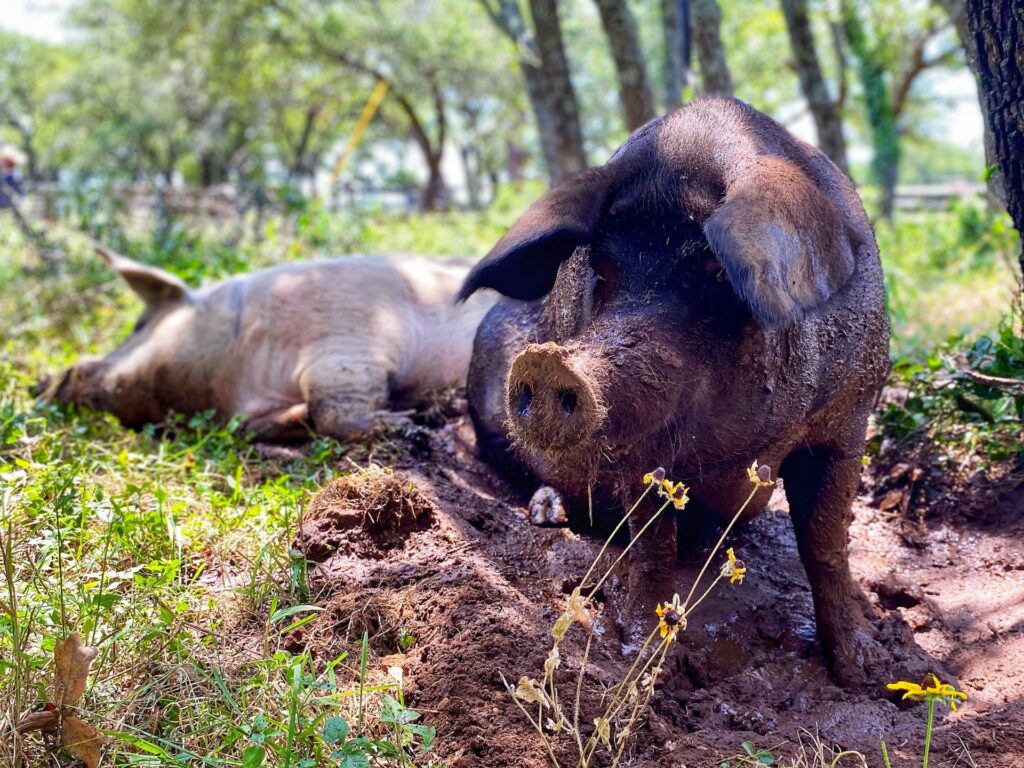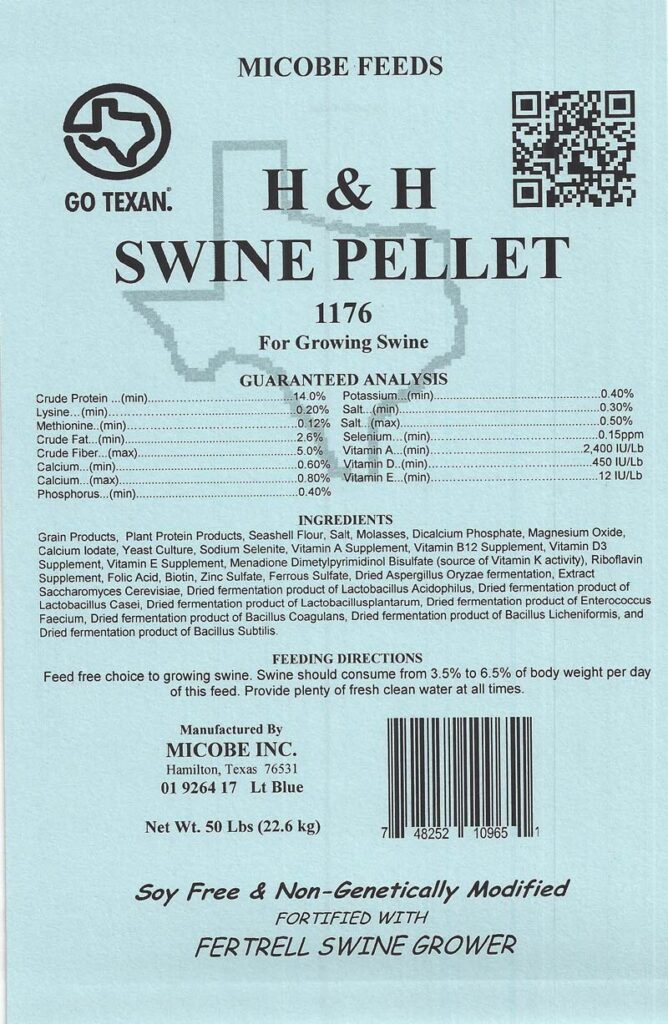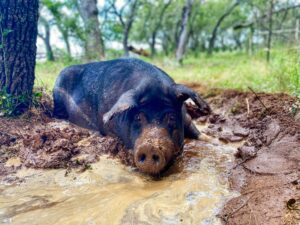Pigs bring a lot of benefits, from producing quality meat to helping manage the land sustainably. For us, bringing home a source of bacon that we can cure ourselves, plus always being stocked on chemical-free pork and lard is a necessary function of our homestead. We started this journey to provide the highest quality nourishment for our family, and pork is certainly a favorite! Once we got them into their first pasture and saw their rooting power, aerating soil that would have taken us hours of work, we quickly became excited about all of the land management potential.
We wrote this guide to help get us to be prepared for our first pigs, Blackberry and Popcorn. With so many resources out there it can easily get overwhelming. This comprehensive guide will walk you through every step of the journey, ensuring you’re well-prepared to care for your pigs and make the most of their natural behaviors. At Mother Luck Ranch, we believe in working harmoniously with nature, and this guide is designed to help y’all do just that.
Paddock Setup
Fencing
Creating a secure environment for your pigs is crucial. Sturdy fencing is your first line of defense against escapes and predators. We recommend using hog panels and or electric fencing specifically designed for pigs, which provide the strength and flexibility needed for effective containment. We have a hot Polly wire for the two as they have been electric fence trained but when the piglets are born we’ll move to netting.
Shelter
Pigs need protection from the elements, whether it’s the hot sun or a sudden rainstorm. A three-sided shelter or a movable pig ark offers the ideal solution, providing shade and a dry space for your pigs to retreat to. We didn’t get the old goat shelter back in shape in time as planned, so our first paddock is in an area with plenty of tree cover. Right now we’re planning to run the pigs through mostly area with tree cover, but if we move them into open land we will opt for building a moveable shelter so it maintains versatility with the practice of rotational grazing. And thinking about it now, it makes sense to just preemptively build a moveable shelter that will work for cattle, pigs, and sheep so that we can use it as we need it, for which livestock we need it, and where we need it. A shade cloth is a great option as well.
Wallow
Especially in the heat of Central Texas, a wallow can be a lifesaver for your pigs. Pigs, much like dogs, do not sweat, so they need our help to keep cool. If you don’t want to build a wallow, well, the pigs are just going to do it for you, so get ahead of it and plan out your wallow management before they do it for you.
Wallows helps pigs regulate their body temperature and provides a place to cool off, which is particularly important during the hot summer months. Even with rotational grazing, having a dedicated wallow area is necessary.
Having a wallow for your pigs is so important that we wrote a whole other blog about it. Check it out: Do Pigs Need a Wallow?
P.S. Around here automation is key, and we love this tip from our friends at Three Sisters Ranch: set a sprinkler on a timer to go off twice a day to keep the pigs cool in their wallow.
Paddock Size and Rotation
Paddock Size
Your pigs need space to roam, root, and explore. We recommend at least 200-400 square feet per pig, which allows them to engage in natural behaviors and reduces stress. More space is always better if you can manage it.
Rotation Frequency
Rotating your pigs is key to maintaining healthy pastures and preventing soil degradation. Aim to rotate them every 2-4 weeks. This gives the land time to recover and keeps your pigs happy and healthy. Use a back-fencing system or movable electric fencing to facilitate these rotations easily.
Considerations
Rotating in smaller paddocks more frequently as mentioned above may work for some farms and ranches. Other farms and ranches may find it better to create larger paddocks and rotate less frequently. Your specific land and availability will determine the best course of action for your unique farm or ranch. There is no cut and dry solution as every terrain and every environment is unique.
If you haven’t read our blog about wallows yet, please do check it out. Land management is a crucial factor in determining paddock size and rotational scheduling. Smaller paddocks will mean more wallows on the farm or ranch. Smaller paddocks also mean more intensive grazing which brings its own value.
Land Management and Soil Regeneration
Rooting Behavior
Pigs are valuable allies in regenerative agriculture due to their natural rooting behavior, which, when managed properly, can significantly enhance soil health without the negative impacts associated with mechanical tilling. Unlike traditional tilling, which can disrupt soil structure, deplete soil organic matter, and harm beneficial microorganisms, pigs gently aerate the soil as they root. This natural aeration improves soil structure, allowing for better water and air infiltration.
As pigs root around, they also incorporate organic matter such as plant residues and manure into the soil. This process enriches the soil with nutrients and stimulates microbial activity, fostering a more vibrant and fertile soil ecosystem. By strategically rotating pigs across different areas of your land, you can avoid overworking any single spot. This rotational grazing approach ensures that vegetation has time to recover, which helps prevent soil erosion and maintains a healthy plant cover.
This method not only enhances soil fertility but also promotes sustainable land management practices. By leveraging the natural behaviors of pigs, you can improve soil health and productivity in a way that aligns with the principles of regenerative agriculture. This approach supports a balanced ecosystem, reduces the need for chemical inputs, and fosters a resilient farming system that benefits both the land and the animals.
Foraging
Allow your pigs to forage in pastures and wooded areas. This not only satisfies their natural instincts but also provides them with a diverse diet rich in nutrients. Foraging helps cycle nutrients through the soil and supports a healthier ecosystem.
Feeding and Nutrition
Feed Composition
Pigs thrive on a varied diet. In addition to allowing them to forage, provide a balanced mix of pasture, grains, and a high-quality swine feed. This ensures they get all the necessary nutrients for growth and health.
Feeding Schedule
Feeding your pigs twice daily—once in the morning and once in the evening—helps maintain their health and energy levels. Adjust the amount based on their age, weight, and activity level. Monitoring their condition will help you tweak their diet as needed.
Supplements
Consider adding supplements like fish oil or flaxseed oil to their diet to provide essential omega-3 fatty acids, promoting healthy skin and a shiny coat. This can be especially beneficial if their primary diet lacks these nutrients.
Thorvin Kelp is an excellent natural supplement to include in your pigs’ diet. It is rich in vitamins, minerals, and trace elements, which can help improve overall health, enhance immune function, and support growth. It is particularly beneficial for animals raised on pasture, where soil nutrient levels might vary.
We offer the Thorvin Kelp as a free choice supplement as a 1:1 ratio with sea salt for our cattle and donkeys. Salt should only account for 0.3% – 0.5% of the daily intake for pigs (up to 1% for breeding sows), and since our swine feed already has that much salt, we simply add the Thorvin Kelp in with the feed.
Water
Pigs need access to fresh, clean water at all times, particularly in the heat of Central Texas. They can drink several gallons a day, so ensure your water source is reliable and accessible. We have our water setup in a 55 gallon food grade drum equipped with automatic waterer nipples.
Manure Management
Pigs produce nutrient-rich manure that can significantly enhance soil fertility. However, proper management is crucial to prevent potential issues associated with manure accumulation. By rotating pigs across different paddocks, you ensure an even distribution of manure, which helps maintain a balanced nutrient and mineral profile in the soil.
Excessive manure in one area can lead to nutrient overload, particularly with nitrogen and phosphorus, which can harm plant health and lead to water pollution through runoff. Too much manure can also create an environment conducive to parasite buildup, posing health risks to your pigs. Rotational grazing helps mitigate these problems by allowing the soil time to absorb and process nutrients effectively, reducing the risk of nutrient leaching and maintaining a healthy, balanced ecosystem. This practice supports sustainable land management and promotes the long-term health and productivity of both your soil and your livestock.
Monitoring Pig Health
Regularly monitoring your pigs for signs of illness or injury is crucial for maintaining their health and ensuring they thrive. Pigs can be quite resilient, but they can also hide symptoms of illness until conditions become severe. Therefore, being vigilant and proactive in observing their health can help catch potential problems early. Here’s a detailed guide on how to effectively monitor your pigs.
Minimize stress by handling pigs calmly and maintaining consistent routines. Pigs thrive on predictability, so try to keep feeding times and daily routines consistent.
Daily Health Checks
Behavioral Changes
Understanding normal pig behavior helps you detect problems early. Healthy pigs are curious, active, and have good appetites. Sudden changes can indicate health issues, so always be observant.
Activity Levels: Note any significant changes in activity. A normally active pig that becomes lethargic could be unwell.
Social Interaction: Watch how pigs interact with each other. Pigs that isolate themselves or show signs of aggression may be in distress or pain.
Resting Patterns: Changes in resting patterns, such as sleeping more than usual or difficulty finding a comfortable position, can indicate health issues.
Appetite and Drinking Habits
• Food Consumption: Monitor their daily food intake. A reduction in appetite or sudden refusal to eat can be an early sign of illness.
• Water Intake: Ensure pigs are drinking adequate amounts of water. Dehydration can quickly lead to serious health problems.
Physical Appearance
Body Condition: Check for weight loss or gain. Both can be indicators of underlying health issues.
Coat and Skin: Look for changes in the coat, such as dullness, roughness, or hair loss. Inspect the skin for rashes, sores, or parasites.
Eyes and Ears: Clear eyes and clean ears are signs of good health. Look for discharge, redness, or swelling.
Weekly Health Inspections
Body Condition Scoring
Perform a body condition score (BCS) check to assess the overall body fat and muscle mass. A BCS that is too high or too low can indicate nutritional or health problems.
Hoof and Leg Health
Examine hooves for cracks, overgrowth, or injuries. Check legs for swelling, heat, or lameness, which can indicate joint or muscle issues.
Digestive Health
Observe feces for consistency, color, and presence of parasites. Diarrhea, constipation, or abnormal color can be signs of digestive problems or infections.
Signs of Illness or Injury to Watch For
1. Respiratory Issues: Coughing, sneezing, nasal discharge, or labored breathing can indicate respiratory infections or conditions.
2. Digestive Problems: Loss of appetite, vomiting, abnormal stool, or bloating can be signs of digestive disturbances or infections.
3. Skin and Coat Issues: Redness, swelling, sores, or excessive scratching can indicate parasites, skin infections, or allergies.
4. Mobility Problems: Lameness, reluctance to move, or abnormal gait can be signs of joint, muscle, or hoof issues.
5. Behavioral Changes: Unusual aggression, lethargy, or isolation from the group can signal pain, discomfort, or illness.
Final Notes
Raising pigs requires thoughtful planning, adequate infrastructure, and daily attention to their needs. By setting up proper paddocks, implementing rotational grazing, and providing essential care, you can ensure the health and well-being of your pigs while benefiting your land and ranch ecosystem.
Remember, each farm or ranch and situation is unique, so adapt these guidelines to suit your specific needs and environment. Happy pig farming!
This comprehensive guide aims to provide practical advice for newcomers to pig farming, ensuring y’all have the necessary tools and knowledge to succeed in raising pigs responsibly and sustainably.


